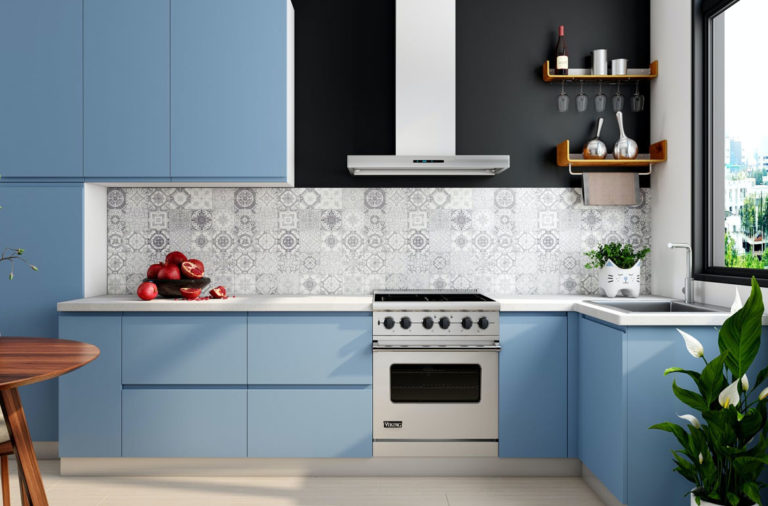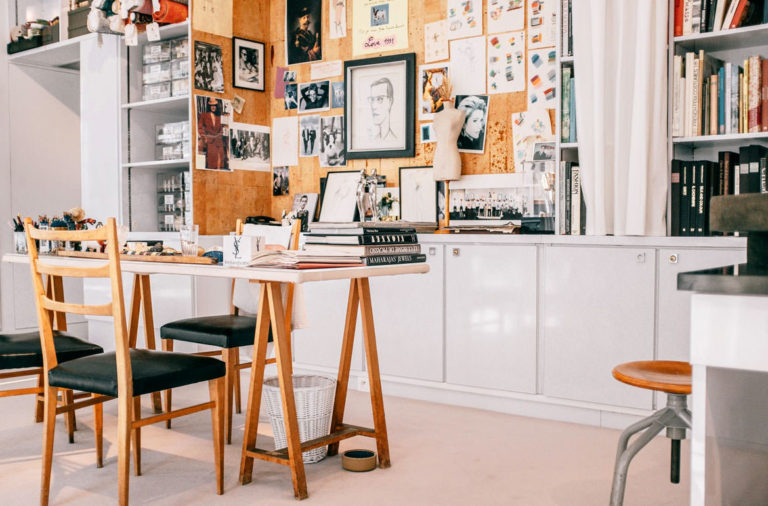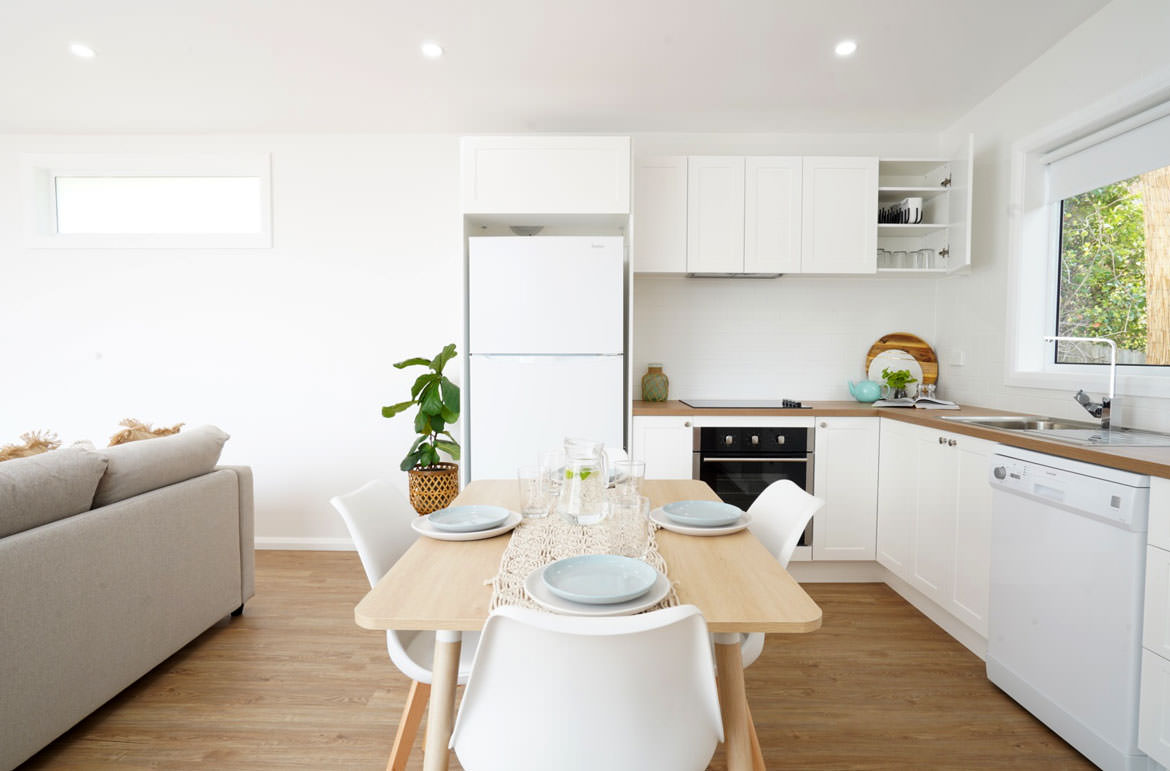
A granny flat is a small area, so there are things you can do to make it feel more spacious.
These are important things to consider when designing a granny flat interior:
- Open Plan Designs
- Multi-functional spaces
- Roof Cavities (if your design allows)
- Built-In Storage Solutions
- Garages, Carports or Sheds
- A 2nd Storey or loft space
- Natural Light – Windows, Mirrors and Decks
Today I will talk about the best designs for small spaces, including how to make a small space feel bigger.
DON'T PAY A FORTUNE FOR YOUR GRANNY FLAT. Find out how to deal with council and build a granny flat for the lowest cost possible. Learn More.
I will discuss how to incorporate an outside deck with indoor/outdoor living, how to consider passive Solar (sun light) and how the rooms should be laid out.
With all this content to cover, let’s get into it!
Best Designs for Small Spaces
A granny flat is a basically a small home.
The size you can build yours ranges from a minimum of 40 square metres to a maximum of 100 square metres, depending on your:
- State
- Council
- Property size and more.
Still, they are quite a small floor-space, so here are some ideas on the best designs for small spaces.
Combine Rooms
More commonly referred to as “open plan” designs, simply combining rooms can make a lot of extra space.
For example, you can have an open plan kitchen that connects to both the dining and living area.
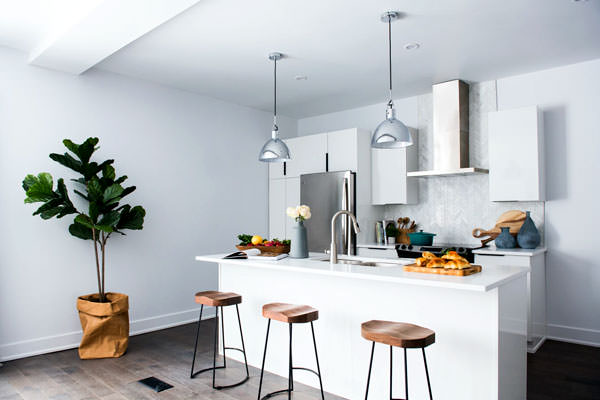
Open plan kitchens can work well in small spaces
As this picture shows, an open kitchen naturally flows into another space, without the use for any dividing walls.
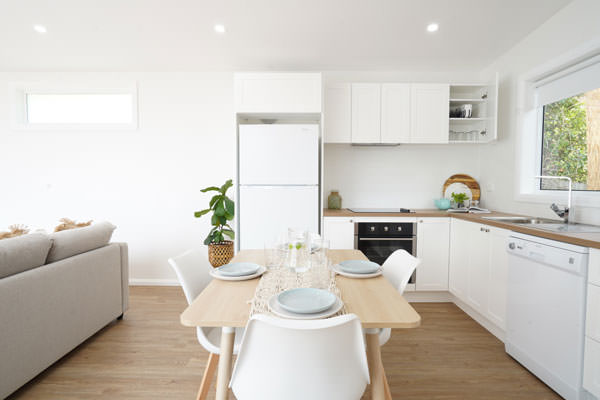
My granny flat kitchen – Opened up to the living space
Another example is combining the laundry and the bathroom, keeping all amenities in one area which:
- Assists those who are less mobile, such as the elderly.
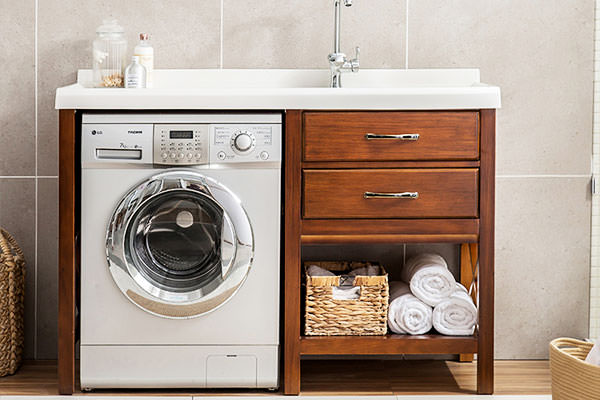
Including the washing machine in your bathroom leaves you with more room
Multi-Functional Spaces
As a granny flat is small, its’ spaces should be adaptable. So, a great idea is layouts that can be used in various ways.
Feel free to read up on architecturally designed spaces for inspiration.
Also; often a under utilised area, there are so many inventive ways to use this vertical space.
For example, it can be used as a storage area.
A permanent staircase is not needed – only a drop-down ladder. This means no essential floor space is wasted.
Built-In Storage Solutions
In granny flats, it is a wise idea if all storage solutions such as shelving, and cupboards are designed in place from the start.
Some examples of great space-saving include:
Kitchen designs with cabinets along the full width of the kitchen wall, or
Practical bedroom designs with built-in shelves above the bed.
Add a Garage, Carport or Shed
You do not need to feel restricted by your square metre floor allowance. You are legally allowed to attach garages, carports, or sheds to your granny flat to extend it.
These areas are all classified as “non-habitable space”, meaning they:
- Will not be counted as part of your allowed living area, and
- You can add them to your granny flat without losing any floor area.
You can even build a 2-storey granny flat, meaning you are allowed:
- A double garage on the ground floor, and
- Your granny flat above it.
This provides you even more space, as your inclusions can be upstairs in your maximum allowed living area, such as:
- One, two, three, even four bedrooms. (If tightly packed in)
- A kitchen in an open plan living and dining area.
- Bathrooms, and
- A laundry.
For the regulations and more information on how you can achieve such a design, feel free to read about using garages to expand the size of your granny flat.
This talks about how, for even more room, you may be allowed a balcony upstairs.
2-Storey Granny Flats
As you may have gathered, a granny flat can be 2-storeys high.
They still have the same maximum size regulations as a single storey granny flat, but with;
- Multiple options you can legally use, which effectively increase their space.
For example, you can increase your floor area by adding a balcony on the second storey.
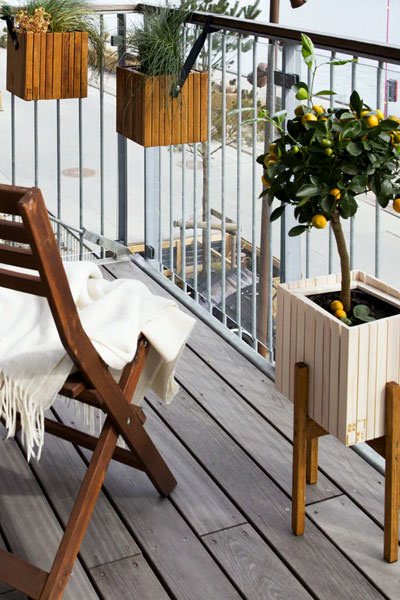
Even if only small, a balcony does make a difference
Similar to a garage or carport, these are not “habitable area”, so they do not take any room from your floor space restrictions.
To clarify, what is included in your maximum allowed floor space of a granny flat is basically all internal areas, such as:
- Bedrooms.
- Kitchen/kitchenette.
- Dining room.
- Living room.
- Bathrooms.
- Laundry.
What is excluded from your floor space (what you are allowed to have in addition to your maximum space), is basically all external areas, such as:
- Decks, patios, porches, verandah’s, awnings, overhangs, or an alfresco.
- Garages/carports.
- Sheds.
How to Make a Small Space Feel Bigger
The number one solution to making a small space ‘feel’ bigger is to add more light.
This is achieved through the use of larger windows.
Although larger windows will not actually increase the amount of space in your granny flat, the natural light will:
- Give you more means to see, thus making the space feel bigger.
- Highlight focal points, whilst brightening compact or otherwise unseen spaces.
- Provide you with a view outdoors, making you feel closer to the outside world, which improves your emotions.
Though, this can be harder to achieve than you may think. You must also consider, for the purpose of:
- Privacy – The size and transparency of the windows.
- The view – The positioning of the windows (a good view is important, a blank wall will make you feel more cramped).
- The direction of the sunlight – The orientation of your granny flat.
So, it can help to enlist the assistance of a professional designer to get exactly what you want.
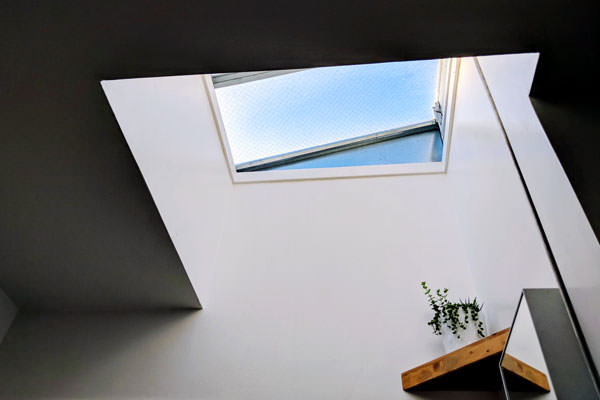
Natural light does wonders for small spaces
You can see that this designer has made the best use of natural light; highlighting a part of the granny flat with a skylight.
And once your windows are in, you can make more of the light by using mirrors (such as in the example above as well).
Mirrors will throw back the light towards isolated areas, which will stop you from having dark spaces around the granny flat.
Enjoy suggestions on where to use these mirrors, and more ideas on how to make a space feel bigger.
How to Incorporate an Outside Deck with Indoor/Outdoor Living
A door that opens onto an outside deck should be considered, as it allows for:
- A perfect source of natural light.
- Lovely views.
- A great balance between indoor and outdoor living areas.
In other words, it “blurs the boundary” from the indoors to the outdoors.
This also makes the living area seem larger.
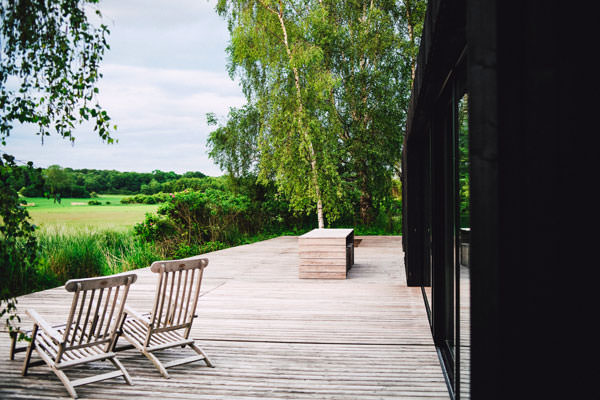
There are a lot less restrictions on how large a deck can be
To make the most of the deck that leads off from the open plan living room, there are also different doors you can use.
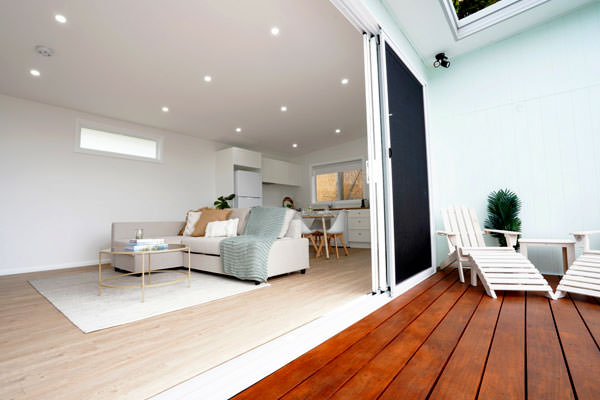
My granny flat – The living space opens to the deck
And instead of using a “stacker door” such as in the photo above a large five panel bi-fold door, or french doors, will add:
- Personality and light to the living room.
Remember, a deck can be very large – it is a way to legally increase your otherwise allowed floor space.
So, when attaching a deck, the only things holding you back is setbacks, your yard space, and budget or course, as they can be expensive if you opt for man made decking or merbau timber as I did.
But to make a deck work for you, for the perfect balance between indoor and outdoor living, try to incorporate a door that suits your personal style.
What Colours Work Best for Smaller Dwellings
It is a common misconception that only light or white colours should be used in small dwellings.
But in a smaller home, there are many different colours from which you can choose that will still give it the appearance of a larger residence.
The key is cohesion, commonly called “flow”, which makes the spaces feel stylish and welcoming.
Here are a few different colours you can use in a granny flat.
Taupe
Taupe is a darker brown colour – between brown and grey. It is trendy and adds a dimensional feature to any living space.
So, it works in the kitchen, study, or even the living area. It looks great paired with other light colours, as this allows for a lot of natural light.
It can also be used in more than one way – paint your walls with this colour or include it in your decor.
Hazel
Hazel is a greenish-blue in colour. It is classic as well as ‘beachy’. Its’ benefit is that it works with many different shades.
So, you can use it in the kitchen with light colours and metallic’s, or in the guest bedroom with bold decor.
Pastel Blue
This lovely shade of blue works well in any spot you place it in, it is extremely adaptable. Use it in the bedroom or even the bathroom.
You can choose a lighter hue for a softer version, or a darker shade for a richer, bolder take.
The idea it to have the colour as the centre of your room, so highlight this hue by combining it with soft shades that don’t disrupt from it.
Grey
Grey is another colour that works well in any room, as it is very flexible.
It works extremely well in the kitchen.
This is as it gives the area a fashionable look – grey can add just enough colour to an all-white kitchen while still leaving it light.
The trick to using grey is having;
Bright, refreshing white throughout, which lightens the shade immediately, and a purple or blue undertone, which gives it a chic vibe.
Oriental Red
Red may seem as though it is a hard colour to work with as it is such a bold shade.
However, it actually works great in an otherwise neutral room.
The trick is to use it in small amounts, in decorative pieces, in rooms with great lighting.
This way it is fun and modern, but not overpowering.
Yellow
Yellow will make a big difference in any room.
It adds a splash of bright, bold drama and cheeriness to any room, regardless of the colours you already have in that room.
Yes, that’s right – if used correctly, yellow will work anywhere and make the room look bigger.
For example, a soft shade of yellow on the wall will bring a fresh, bright touch to a room.
Or, a yellow table will add a touch a brightness.
Patterns
But, if used correctly, a piece of pattern can make the space it is in look bigger.
The trick is to use similar patterns in similar colours, in small doses. Never use too many patterns in a small room.
Keep it simple by using similar colours to those already in the room, and you can get a great result.
Other handy hints are:
- Use clean, sharp, straight lines.
- Figure out the aesthetics you’re after (i.e. coastal or “Hamtons-esque”), then stick to that one style throughout.
- Balance is key – keep the deep, rich colours only in the essentials and you have perfected it!
Where Should Bedrooms be in Relation to Kitchen and Bathroom
Kitchens and bathrooms are the most difficult rooms to place, as they are the most complex.
This is because they need:
- Plumbing.
- Wiring, and
- Sometimes, structural modifications to support the toilet.
If possible, place each bathroom (that is, the main bathroom and a second bathroom if there is one);
- Back-to-back with the kitchen.
By sharing the same “wet wall” between the bathrooms and the kitchen, this;
- Reduces the length the pipe must run, and
- Streamlines the drain and vent stack connections.
Next, place each bedroom at the quietest part of the granny flat.
This is typically the part of the dwelling that is farthest away from the main home / primary road, as sound travels easily.
For the same reason, if you have more than one bedroom, having a living area between the bedrooms allowing for their separation is ideal.
See an example of a great design at Granny Flat Approvals.
Where Should the Living Room be in Relation to the Sun
This basis of this design is based on “passive solar heating”, which requires the living room to be north facing, so;
- The living areas are exposed to full sun.
The Department of the Environment, Water, Heritage and the Arts Annual Report 2008 (DEHWA 2008), showed;
- Passive solar heating uses free heating directly from the sun to;
- Significantly minimise the estimated 40% of energy used in the typical Australia home on heating and cooling.
Passive solar heating is the cheapest way to heat your home.
The majority of Australian homes require both passive heating and cooling (different prominence is required depending on your climate).
The way your home is designed for passive solar heating aims to:
- Keep the sun out in summer and let it in during winter, while ensuring the buildings’ thermal efficiency allows it to;
- Hold on to the heat in winter, but let it escape during summer.
It doesn’t cost much when designed into a new granny flat, and achievable through things including correct orientation.
The best orientation is true north, but orientations of up 20 degrees west of north and 30 degrees east of north still work well.
This placement increases winter heat gain, reduces winter heat loss, focusing heat where it is needed most.
What Position is Best to Face a Home
A home with the main living areas that are north facing has many advantages, including;
- These spaces can maximise the natural light as the sun moves from east-to-west.
- This access to the sunlight means you can get the most direct sunlight during the day, especially through winter when the sun is scarce.
Conclusion
It’s the little things that can make a big difference to your granny flat.
Design is an important factor for giving your granny flat a spacious feel, including:
- Combining rooms.
- Multi-functional rooms.
- Flow of warm, welcoming, stylish colours.
- Built-in storage solutions, i.e. roof cavities, kitchen cabinets or shelving, and
- Layout – i.e. placing the kitchen and bathrooms on the same wall and separating the bedrooms.
There are also many things you can add to your granny flat that do not take away from your allowed floor space, including:
- Decks, which can create the perfect balance of indoor and outdoor living.
- Garages/carports.
- Sheds.
- Roof cavities, or
- A second storey, which can add significantly more room if correctly designed.
It’s crucial to consider the use of natural light when designing your granny flat – both through the use of windows, mirrors and orientation.
Just facing your granny flat, in particular the living areas, to the north, allows for more direct sunlight to enter where needed most.
This orientation allows for passive solar heating – the least expensive way to heat your granny flat.
Passive solar heating allows the sun to stay out in summer and come in during winter, whilst the thermal efficiency aims to:
- Keep the heat in winter but allow it to get out during summer.



